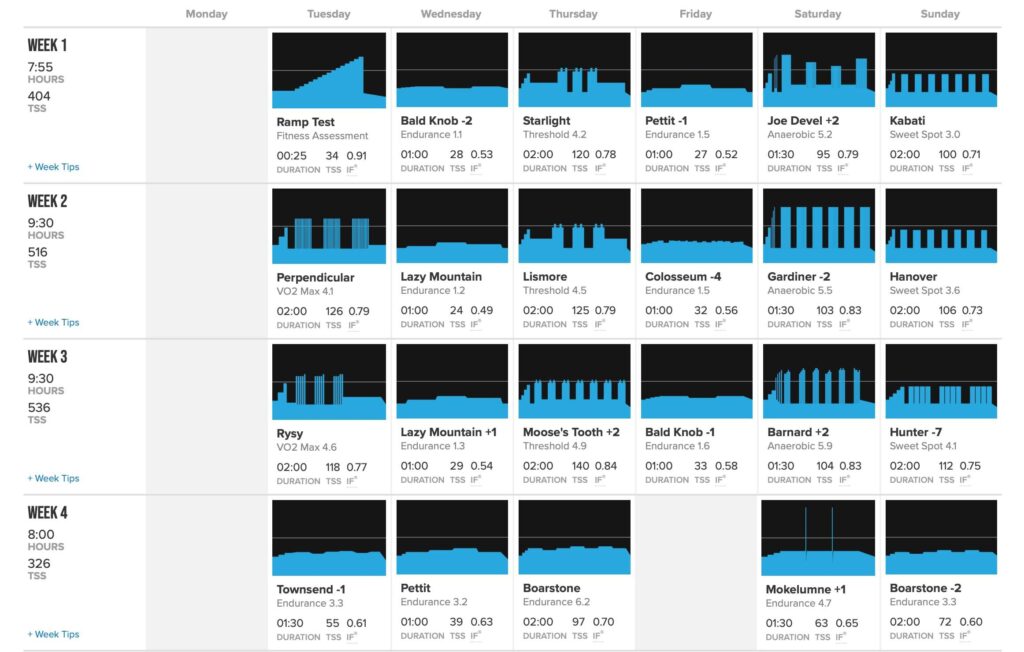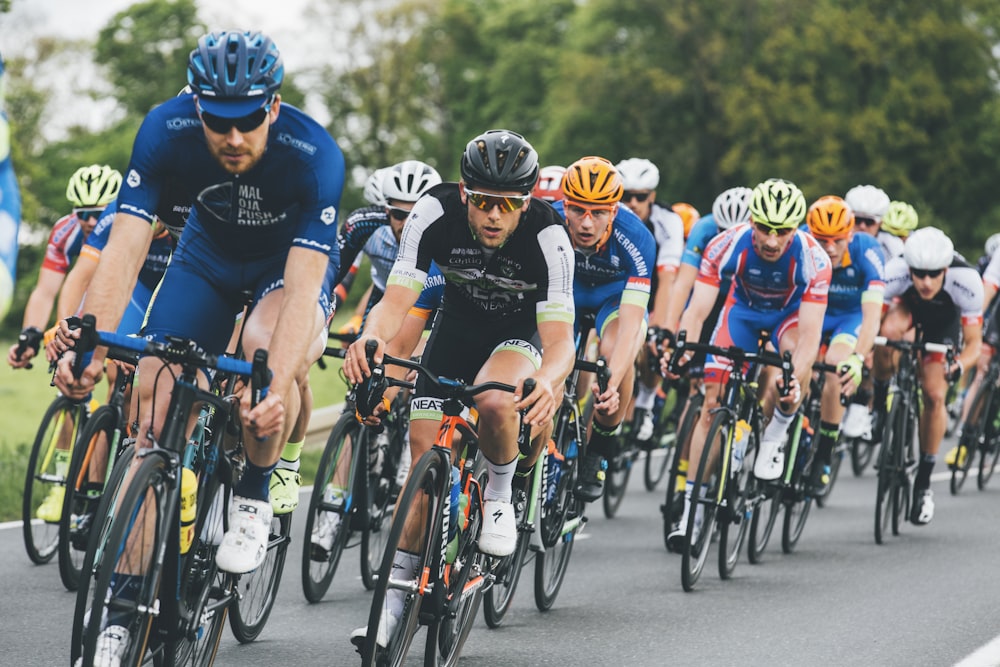How to Improve Your Cycling Performance
The drive to improve performance is common at all levels of cycling.
The motivations range anywhere from wanting to get to work faster to friendly competition between friends when tackling a local hill segment. For the purposes of this article, we will address power, endurance, and grit as aspects to develop for improved performance.
There are, however, many other aspects that will improve cycling performance, including but not limited to: technique, equipment, and route preparation.
The ability to improve in any one aspect varies greatly among individuals. Each person has the ability to improve performance in each category, and there is a myriad of factors at play. We will try to distill the seemingly endless advice in the cycling community, into the easiest and best value implementations which will help you make the desired changes to your performance on your next ride.
Let’s start with some common definitions.
Aerobic vs. Anaerobic Training
- Aerobic exercise (using the body’s aerobic energy system) is often associated with endurance training that happens at a heart rate where the body can still use oxygen along with fat and glucose for energy creation in the body. The activities that improve your aerobic function are generally rhythmic in nature: brisk walking, cycling, light running, and swimming.
- Anaerobic exercise is usually high-intensity and short duration, at a high heart rate. The body must break down glucose in the absence of oxygen to create energy, with lactic acid as a byproduct (this contributes to the burning sensation experienced during high-intensity training). Activities include: sprinting, high-intensity interval training (HIIT), and weightlifting.
What is VO₂ Max?

Your VO2 Max is a measure of your maximum oxygen consumption during incremental exercise and a good indicator of cardiovascular fitness. This is typically measured and scored in a lab setting (you need specific lab equipment to measure accurately).
While being a good marker for overall health (the higher the score, the lower the chance of developing some lifestyle-related diseases), it is not a good marker for overall endurance among trained individuals, and therefore doesn’t require much consideration from most people.
Improving your score will come as a result of diverse aerobic and anaerobic training, and there are several other factors that contribute to overall endurance and cycling performance.
Training Zones & Aerobic Heart Rate Training
Training zones are levels of output based on specific percentages of an individual’s VO₂ max. As most people do not have the ability to measure their VO₂ max in a lab, exercisers began using their max heart rate to identify the zones.
Dr. Iñigo San Millán of the University of Colorado School of Medicine has more accurately identified these zones based on activation of the various muscle fibers in the body.
There are 5 or 6 ‘zones’.
For zone 1 and 2, Type-1 muscle fibers are used, meaning fat is the preferential fuel source. This piece of knowledge is extremely useful for those who want to lose fat and/or build endurance.
Training in zone 2 (or in an aerobic state) is done by monitoring the heart rate and staying just below maximum aerobic heart rate (MAHR). This is often identified as 50-60% or 60-70% of a max heart rate (the community is divided on which specifically).
A more specific and targeted formula is outlined by Dr. Phil Maffetone (Clinician & coach of world-class endurance athletes). This method factors in some extra variances among individuals to give a more accurate number. Find this number and then complete around 80% of training at, or just below, this heart rate to build endurance and, according to Dr. Maffetone, help avoid injuries and overtraining.
Of course, in order to accurately measure your efforts, you need to train with a power meter.
The Psychological Effect
Modern scientific understanding is that human performance is not only limited by one’s physical capability but is impacted greatly by the strength of the mind and the brain’s own internal regulators.
There are two main theories related to the brain’s role in performance outlined by Alex Hutchinson in his book Endure: Mind, Body, and the Curiously Elastic Limits of Human Performance.
- The first is that the brain is a “central governor”. Tim Noakes, a South African professor who studies the brain’s effect on performance, posits that the brain controls endurance with protective anticipatory mechanisms that stop you from over-exerting yourself, avoiding, for example, overheating (resulting in heatstroke).
- The second is that performance is limited by a balance between perceived exertion (how hard the effort feels) and motivation (how hard you’re willing to push). This theory has been put forward by Samuel Marcora, a professor of clinical exercise physiology at the University of Wales-Bangor.
Both beliefs are likely to be true to a certain degree, and thus a picture forms of the important interplay between the brain, individual strength of mind, and physiology. This means that in order to improve performance it is vital to train the body and the mind, so you have the ability to push through adversity and unlock your potential.
High-Intensity Interval Training (HIIT) Cycling Workout
One guaranteed way to improve your overall performance fitness and mental toughness is by using HIIT.
This training method involves rotating intervals of high effort and low effort. On a stationary bike, this may look like 30-90 seconds at 80-100% effort (very high resistance), followed by 30-90 seconds of active rest (low resistance).
The formula is flexible, as long as it is both challenging and includes enough recovery time. HIIT is more suitable as an indoor cycling workout, as resistance can be changed at will and it is safer to be stationary while giving max effort.
HIIT helps improve overall cardiovascular fitness, while also providing a chance to push through unexplored pain barriers. Trying to maintain max output (e.g wattage or RPM) on the exercise bike for a given time may help push you past what you thought you could do.
High-intensity exercise has been shown to improve pain tolerance and thus may cause equal performance gains through an ability to push through the pain (lactic acid build-up) during big efforts on the bike.
Set Goals & Track Progress

TrainerRoad Training Plan Updates with Workout Levels (Image source: trainerroad.com)
In any aspect of life where you hope to improve it is important to set goals and cycling performance is no different.
When setting goals, ensure they are incremental, measurable, and achievable. Always be flexible with time frames, as life will inevitably get in the way be it through injury or simply a busy schedule.
It is important to remember that even a 1% improvement toward your goal is worth celebration.
If you face setbacks, be encouraged by the “body’s memory” and, according to science-backed research, it will likely be easier to make back the lost gains the second time around.
Setting incremental goals is important: it is motivating to reach a goal you have set. Getting in the habit of periodically measuring goal markers (like how fast you can climb your local mountain road) when working toward an end goal allows for better analysis of your system so you can make necessary modifications along the way.
Another strategy for goal setting is breaking down a goal into relevant skills, and even further into simple actional areas. With cycling performance this may look like:
This is a simplified representation, yet it’s easy to see how including each training modality into a cycling workout plan will contribute toward the overall goal. Consider setting a goal that slightly pushes the limits of what you believe you are capable of, so that you do not stay within your comfort zone and become complacent.
One last tip for goal setting relates to strengths and weaknesses. People have a natural tendency to gravitate toward their strengths; spending less time on weaknesses. This often comes at the detriment of the skillset as a whole. In these situations, an individual would benefit more by dedicating extra time to weaknesses, in order to support all-round performance.
The exception to this rule is if the individual wants to specialize. This will require greater time dedicated to one area of performance regardless of others. A real-life example of this can be seen in a cycling sprinter who struggles greatly in mountain terrain because of the training focus on strength and power in short bursts for enhanced sprint finishes.
Don’t Rely On Motivation
If you want to improve your cycling performance, don’t rely on inspiration and motivation for every workout or training session.
Motivation is a limited resource that ebbs and flows throughout our lives. We can’t control it, and we don’t know when it will decide to show up or leave us high and dry.
What you can control are your actions. If you understand what you need to do to get to where you want to be, and you allocate the time in your schedule to do it, you will give yourself the best shot at getting there!
Routine and consistency help to normalize any desired actions.
Where possible, tell yourself “On Monday I do X, on Thursday I do Y, and on Sunday I do Z”, creating a set, yet flexible, space in your calendar.
A final point on motivation relates to starting an action or what’s called “activation energy” (AV). By choosing an action that is small, you need less energy or push to begin. For example, if you schedule a 1-hour leg/core workout on Mondays, the drive or ‘AV’ needed to follow through is substantial, and many things may interfere with completion. Conversely, if you schedule 10+ minutes, you have the option of completing a short workout focusing on 2 key exercises, or a comprehensive 45-min workout.
Measuring Progress
To know if you are improving, it is good practice to record metrics such as your times, perceived exertion during a specific segment, heart rate, strength, etc. Measuring improvements, no matter how slight, will help boost motivation and can help you identify when your process needs to be adjusted due to a plateau in growth, thus “managing” your training regime.
Keeping a training journal is an excellent way to measure and plan your workouts. You could do this with a phone app or a notebook, but recording down the metrics you can measure from your workout will help you see where you are improving, or what you need to work on more.
“You can’t manage what you can’t measure.” – Peter Drucker
Spin bikes at the gym are excellent for this, as most give you various metrics, but it’s important to make sure to choose the same piece of equipment each time
Heart rate monitors, like Wahoo or Garmin products (straps and watches), can give a rough estimate of heart rate, and are important if you want to train in a specific zone (such as under the MAHR explained earlier).
Bicycle computers & cadence sensors, and wattage power meters are other measurement tools available to add to your bicycle if you are getting serious about training.
Training Modifications
The body is a remarkably efficient and adaptable machine. If you train in a certain way regularly, your body will strengthen, grow, and improve so that it can cope better with the stimulus it is experiencing. For this reason, it is important to modify training routines regularly, to ensure continued improvement by stressing your body in different ways to keep it guessing/adapting.
It is important to note that performance is a moving target and many factors can affect it on a given day. This is why it is important to record and track progress in blocks so that you are not discouraged by loss in performance due to stress, poor sleep, or any other number of factors.
- Speed – One excellent way to incrementally improve your average cycling speed is training at or just below MAHR (requires a heart rate monitor), at a pace sustainable over long distances. If you can ride a given route at 15mph at your MAHR, complete your training session at this heart rate, and given adequate rest/nutrition, your body should adapt so that the next session you can ride at 15.5mph and maintain the same heart rate as before.
- Strength – To improve strength, you can modify exercises by adding resistance, changing the tempo of an exercise (the time it takes to lift, hold, and lower), or by changing the number of sets or reps.
Fasted Training – A relatively modern training technique that involves skipping breakfast before a morning workout. The idea behind training fasted is that it improves metabolic flexibility (how well your body uses different fuel sources) thus increasing your performance. Other benefits may include:
- Increased fat burning
- Improved ability to perform without food
- Enhanced recovery
Group Cycling and Performance
Riding in a pair or as part of a group is surprisingly effective at boosting performance due to the competitive effect and, in certain circumstances, a fear of being left behind. Most cyclists would testify to the improvements seen in their performance when riding with other cyclists at or above their level.
The effect of group riding on the brain gives access to an extra gear that is difficult to unlock during a solo ride.
Cycling Workouts & Cross-training
- Cross-training is done by supplementing your cycling workouts with other exercises such as strength training, running, swimming, hiking, or yoga. The importance of cross-training is sometimes overlooked among us cyclists (as we tend to focus our exercise passion solely in the saddle) but by performing various types of exercise, you can significantly boost your cycling performance while also helping avoid imbalances, overuse injuries, and muscle strains that come as a result of the highly repetitive nature of cycling.
- Running is an excellent way to maintain and improve cardiovascular fitness that transfers directly to cycling. Running also conditions the lower body and trunk muscles which are key to cycling performance.
- Swimming is especially effective as it is very low impact, allowing one the ability to train cardiovascular fitness without straining joints involved in cycling or running
- Hiking on trails is excellent for lower body strength, and steep gradients or uneven terrain requires strength and stability, both of which complement cycling.
- Yoga is the perfect addition to any exercise routine. A focus on the mind-body connection, control of the breath, mobility, and core strength, make yoga a uniquely effective workout for any cyclist.
- Strength training is fundamental to every sport and exercise. Targeted bodyweight- or weight-training improves stability, control, bone density, and develops the muscles and joints needed to perform more dynamic activities like cycling or running.
A cycling leg and core workout may involve 6-8 different exercises which help to cover the main muscle groups in each area.
Common leg exercises include: squats, kettlebell swings, deadlifts, and glute bridges. (One-legged variations of the squat and deadlift will also help improve balance and stability).
Common core exercises include: plank, side plank, palloff press, and hanging/lying leg raises.
It is always important to develop a good technique for each exercise before adding weight! Use control, activate the appropriate muscles and breathe consistently to gain the most benefit.
Maintaining Overall Health
If you want to improve and sustain your cycling performance, time and attention should be dedicated to the core aspects of health and nutrition. Without doing so, you put yourself at risk of injury and overtraining.
In one study of 518 amateur cyclists, 85% had experienced an overuse injury, many of which may have been avoided by putting an emphasis on good quality training and recovery.
Body Weight & Composition
Excess body weight has a direct effect on cycling performance, most notably while climbing hills. More muscle (and weight) is needed for cyclists who wish to improve their power. That being said, positive changes to body composition (muscle to fat ratio) and reduction of excess body weight will come as a result of cycling regularly, as long as good health and wellness principles are followed.
Mobility
Mobility work for cycling is crucial for a comfortable ride. It also helps avoid or better enable recovery from injuries. Implement pre and post-ride mobility work with a foam roller and lacrosse ball, along with yoga if possible, and you will be prepared for life both on and off the bike. You can check out our article on injury prevention and rehab for cycling with lots of tips to add to your routine.
Fuelling & Overall Nutrition
Eating a varied diet of mostly whole, minimally-processed foods will improve your cycling performance and add vitality to your day-to-day life. Cooking most meals at home and creating a positive food environment (keep healthy snacks around) are two tricks for improving your food habits.
Our article on nutrition for cycling outlines some helpful tips to ensure you give your body what it needs so you can crush your next ride.
Sleep & Recovery
Adequate sleep and recovery time is equally important to improving cycling performance as the exercise itself. Tied closely to this is the minimization of prolonged stress (bad stress), good nutrition, and body maintenance. Guidelines for sleep vary greatly, but at minimum, we should aim for 7 hours with 8 hours being ideal, up to 9 hours may be needed after very intense or long-duration exercise.
It is during the recovery time that your body makes the adaptations necessary to improve performance. The short-term stress (good stress) i.e. exercise, is what triggers your body’s recovery and growth response, so the next time you complete that exercise in the same conditions, you are stronger and better adapted.
FAQ
Is cycling a good workout?
Cycling is an excellent way to train your cardiovascular fitness, as well as improve leg strength. There are different ways to train while cycling, and depending on the one you choose, there will be different outcomes for your fitness, which we have highlighted above. Cycling should be supplemented with other exercise types to evenly train the whole body.
What muscles does cycling workout?
Cycling primarily uses the quadriceps muscles (a group of 4 in the front of the thigh), the muscles in the buttocks (glutes), and the hamstrings (back of the thigh). The calf muscles are used secondarily, along with the core for stabilization, and the shoulders and arms.
Is indoor cycling a full-body workout?
It depends. There are some indoor cycling classes (spin cycling), that include upper bodywork as part of the class, however, this varies from gym to gym. Regular spin bike cycling will have very similar effects to cycling on the road or trail.









I love how you stated that a great way to promote improvement in cycling is to regularly modify your training routines. My dad wants to become a better cyclist so he can be more prepared for a race he is doing in the spring. I think it would be a good idea for my dad to hire a cycling coach to help him create various training routines.